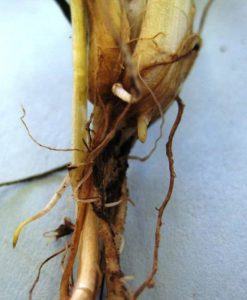
Shawn P. Conley, Soybean and Wheat Extension Specialist, Department of Agronomy, University of Wisconsin
As we begin to contemplate spring and the 2019 winter wheat growing season, many growers and consultants alike are beginning to venture out and across their winter wheat fields to assess winter injury and nitrogen timings. Though it is a bit premature to make any rash decisions regarding crop destruction here are a few considerations for assessing your spring 2019 winter wheat stands.
-
As you look across your wheat landscape vibrant green patches will be interspersed with drab brown areas. The brown areas do not necessarily indicate those plants are dead.

Arlington Winter Wheat Variety Trial – Roadside Assessment 
In Field Stand Assessment 
Planting Depth and Tiller Assessment Growers and consultants can either reassess in a week or pull plants from the field and place in warm environments. Milk houses and kitchens work perfect. Root regrowth will appear from the crown and will appear as vibrant white roots as shown below.
Spring Root Regrowth in Winter Wheat If plants do not recover our critical threshold for turning over a field is 12 to 15 live plants per square foot. Below this threshold (< 12 plants per square foot) is an automatic replant decision.
- In regards to N application timing for winter wheat that decision is pretty darn simple. Research from Dr. Carrie Laboski’s program indicates that the optimal time to apply nitrogen to wheat in WI is green-up regardless of tiller count. For more detailed information check out her blog article here: Time your spring nitrogen applications to maximize winter wheat yield.
- Also remember that wheat grain in itself is only part of the revenue you capture with winter wheat. The price of winter wheat straw remains strong and roughly ~11% less acres of winter wheat were established last fall than the previous year (2017/18). Please consider that revenue stream before any replant decisions are made.
- If you decide your wheat crop is not worth keeping (i.e. you can tell your neighbors your planted a planned cover crop last fall) please remember to terminate it a minimum of two weeks before you establish your next cash crop. Click for more details on Cover Crop Do’s and Dont’s
Read the original article at: https://coolbean.info/2019/04/02/factors-to-consider-while-assessing-your-2019-winter-wheat-crop-stand-and-spring-nitrogen-timing/